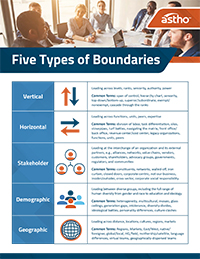Using Boundary Spanning Leadership to Improve Population Health
June 14, 2023 | Alice Schenall
 To improve population health, it’s critical to engage sectors beyond public health. Regardless of one’s proximity to power, being able to lead across boundaries is crucial to achieving optimal health for all. It shows skill in navigating through differences in values, regulations, or perspectives protected by levels of authority and various stakeholders. Without a doubt, this task can be daunting when a leader lacks confidence in their abilities.
To improve population health, it’s critical to engage sectors beyond public health. Regardless of one’s proximity to power, being able to lead across boundaries is crucial to achieving optimal health for all. It shows skill in navigating through differences in values, regulations, or perspectives protected by levels of authority and various stakeholders. Without a doubt, this task can be daunting when a leader lacks confidence in their abilities.
There is a growing need to train all levels of the public health workforce in boundary-spanning principles to build capacity to serve fellow colleagues and the community. The boundary spanning leadership (BSL) practice develops the capability to create direction, alignment, and commitment to achieve a higher goal or vision for public health. BSL provides a framework to develop a theory of change that depends on human-centered relationships and processes to achieve that higher goal.
Understanding boundary spanning principles helps public health practitioners recognize the types of boundaries that come naturally when navigating relationships that may involve managing up, down, and across. These challenges can range from geographic and demographic or to those personal-level boundaries some leaders may seek to avoid (i.e., mental models). Successful leaders take the key steps to learn how to lead across differences.
BSL is useful for public health leaders who navigate during critical moments, such as natural disasters and disease outbreaks. States/Territories also use BSL to operationalize equity, leverage funding, and create better business processes across agencies.
BSL in Action
In February 2023, I had the privilege of facilitating an in-person workshop covering core BSL topics for the Guam Department of Public Health and Social Services (DPHSS). Guam formed a cross-agency leadership team made up of five agencies. That team invested by gaining input from partner agencies and understanding each other’s challenges related to the ever-present issue of procuring needed goods and services.
This boundary spanning work led to direction, alignment, and commitment to eliminating waste and redundancy. Guam began strategizing how to craft standing operating procedures and a training plan with each of the five agency’s roles and responsibilities. After the BSL training, a DPHSS staff member shared that the training “opened the doors of communication with other departments, which [was] a huge step in bringing [their] counterparts to the table.”
ASTHO hosted another in-person workshop in the U.S. Virgin Islands (USVI). During the session, USVI government leaders and project teams from nine programmatic and administrative agencies used boundary spanning leadership principles and practices and to develop “one vision” for their business process improvement work. The project team spanned vertical, horizontal, demographic, and geographic boundaries (across islands) to launch a new “e-enabled” federal grants planning and set-up process. Interagency collaboration fueled better understanding of internal customer needs, process standardization, and visibility across agencies.
At the Nevada Department of Health and Human Services, the Boundary Spanning Leadership course allowed the agency to expand Nevada’s Strategy to Repair Equity and Transform Community Health (STRETCH) initiative. The department reached out statewide to better understand community members in the more diverse Clark County (Las Vegas) area. In turn, they started forging common ground—and laying out important differences—with partners who also wanted to reduce health disparities. Nevada has improved relationships with current partners and brought new partners together to try to braid funding for mutual connectiveness, trust, and to discover new frontiers.
Boundary Spanning Leadership supports developing a strategic plan to leverage funding and relationships to sustain meaningful change that leads to a better state of health for all.
Many thanks to ASTHO’s Kristin Sullivan, MA, director of public health systems improvement and infrastructure and Cendra Clarke, MA, senior analyst of evaluation as well as Godwin O. Nwando, MPH, health equity manager with the Nevada Department of Health and Human Services for their contributions to this blog post.